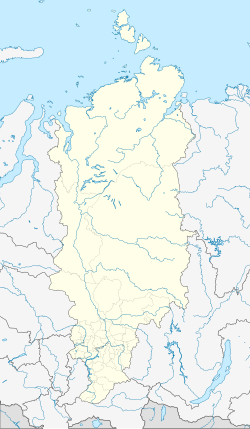Dikson (urban-type settlement)
Dikson
Диксон | |
|---|---|
| Coordinates: 73°30′30″N 80°31′28″E / 73.50833°N 80.52444°E | |
| Country | Russia |
| Federal subject | Krasnoyarsk Krai |
| Administrative district | Taymyrsky Dolgano-Nenetsky District |
| Founded | 1915 |
| Elevation | 26 m (85 ft) |
| Population | |
| • Total | 676 |
| Time zone | UTC+7 (MSK+4 |
| Postal code(s)[3] | 647340 |
| Dialing code(s) | +7 39152 |
| OKTMO ID | 04653155051 |
| Website | dikson-taimyr |
Dikson (Russian: Диксон) is an urban locality (an urban-type settlement) in Taymyrsky Dolgano-Nenetsky District of Krasnoyarsk Krai, Russia. It is a port on the Kara Sea, located on a headland at the mouth of the Yenisei Gulf (the Yenisei River estuary), on Russia's Arctic Ocean coast. As of the 2010 Census, its population was 676.[1]
Location

Dikson is the northernmost port in Russia, one of the northernmost settlements in the world, and the northernmost settlement on the Asian continent. It is located so far north that one may experience complete darkness with no civil twilight from the 8th of December to the 5th of January. In most major settlements north of the Arctic Circle, there is still substantial twilight during the polar night at midday. It is also one of the most isolated settlements in the world.
Dikson's inhabitants informally call their settlement a "Capital of the Arctic", a name taken from a popular Soviet song.
The urban-type settlement of Dikson, as well as Dikson Island, were named after Swedish Arctic pioneer Baron Oscar Dickson. Dickson, along with Aleksandr Mikhaylovich Sibiryakov, was the patron of a number of early Arctic expeditions, including Adolf Erik Nordenskiöld's Russian Arctic explorations.
Population
| 1989[4] | 2002[5] | 2005 | 2007 | 2008 | 2010[1] |
|---|---|---|---|---|---|
| 4,449 | 1,198 | 883 | 742 | 690 | 676 |
Unlike the rest of Russia, children under the age of 12 make up 20% of the population. In the rest of Russia, this number is 15% [6]
Climate
Dikson has an arctic climate (Köppen ET).
| Climate data for Dikson | |||||||||||||
|---|---|---|---|---|---|---|---|---|---|---|---|---|---|
| Month | Jan | Feb | Mar | Apr | May | Jun | Jul | Aug | Sep | Oct | Nov | Dec | Year |
| Record high °C (°F) | −0.5 (31.1) |
−1.3 (29.7) |
−0.2 (31.6) |
1.8 (35.2) |
10.4 (50.7) |
22.4 (72.3) |
26.8 (80.2) |
26.9 (80.4) |
17.0 (62.6) |
8.1 (46.6) |
1.9 (35.4) |
0.3 (32.5) |
26.9 (80.4) |
| Mean daily maximum °C (°F) | −22.5 (−8.5) |
−21.9 (−7.4) |
−18.4 (−1.1) |
−13.4 (7.9) |
−5.5 (22.1) |
1.9 (35.4) |
7.2 (45.0) |
7.2 (45.0) |
2.9 (37.2) |
−6.3 (20.7) |
−15.2 (4.6) |
−19.7 (−3.5) |
−8.6 (16.5) |
| Daily mean °C (°F) | −23.9 (−11.0) |
−25 (−13) |
−21.7 (−7.1) |
−17.2 (1.0) |
−8.3 (17.1) |
0.1 (32.2) |
3.9 (39.0) |
5 (41) |
1.7 (35.1) |
−8.4 (16.9) |
−18.4 (−1.1) |
−21.7 (−7.1) |
−11.1 (12.0) |
| Mean daily minimum °C (°F) | −29.4 (−20.9) |
−29.3 (−20.7) |
−26.0 (−14.8) |
−20.9 (−5.6) |
−10.6 (12.9) |
−1.5 (29.3) |
2.1 (35.8) |
3.0 (37.4) |
−0.3 (31.5) |
−11.1 (12.0) |
−22.0 (−7.6) |
−26.7 (−16.1) |
−14.4 (6.1) |
| Record low °C (°F) | −46.2 (−51.2) |
−48.1 (−54.6) |
−44.4 (−47.9) |
−38.0 (−36.4) |
−28.8 (−19.8) |
−17.3 (0.9) |
−3.4 (25.9) |
−3.6 (25.5) |
−12.0 (10.4) |
−31.3 (−24.3) |
−42.8 (−45.0) |
−46.6 (−51.9) |
−48.1 (−54.6) |
| Average precipitation mm (inches) | 35 (1.4) |
27 (1.1) |
22 (0.9) |
18 (0.7) |
20 (0.8) |
29 (1.1) |
35 (1.4) |
44 (1.7) |
41 (1.6) |
33 (1.3) |
22 (0.9) |
32 (1.3) |
358 (14.1) |
| Mean monthly sunshine hours | 0.0 | 22.6 | 127.1 | 237.0 | 189.1 | 141.0 | 223.2 | 139.5 | 60.0 | 24.8 | 0.0 | 0.0 | 1,164.3 |
| Source 1: Погода и Климат[7] | |||||||||||||
| Source 2: HKO[8] | |||||||||||||
References
- ^ a b c Russian Federal State Statistics Service (2011). Всероссийская перепись населения 2010 года. Том 1 [2010 All-Russian Population Census, vol. 1]. Всероссийская перепись населения 2010 года [2010 All-Russia Population Census] (in Russian). Federal State Statistics Service.
- ^ "Об исчислении времени". Официальный интернет-портал правовой информации (in Russian). June 3, 2011. Retrieved January 19, 2019.
- ^ Почта России. Информационно-вычислительный центр ОАСУ РПО. (Russian Post). Поиск объектов почтовой связи (Postal Objects Search) (in Russian)
- ^ Всесоюзная перепись населения 1989 г. Численность наличного населения союзных и автономных республик, автономных областей и округов, краёв, областей, районов, городских поселений и сёл-райцентров [All Union Population Census of 1989: Present Population of Union and Autonomous Republics, Autonomous Oblasts and Okrugs, Krais, Oblasts, Districts, Urban Settlements, and Villages Serving as District Administrative Centers]. Всесоюзная перепись населения 1989 года [All-Union Population Census of 1989] (in Russian). Институт демографии Национального исследовательского университета: Высшая школа экономики [Institute of Demography at the National Research University: Higher School of Economics]. 1989 – via Demoscope Weekly.
- ^ Federal State Statistics Service (May 21, 2004). Численность населения России, субъектов Российской Федерации в составе федеральных округов, районов, городских поселений, сельских населённых пунктов – районных центров и сельских населённых пунктов с населением 3 тысячи и более человек [Population of Russia, Its Federal Districts, Federal Subjects, Districts, Urban Localities, Rural Localities—Administrative Centers, and Rural Localities with Population of Over 3,000] (XLS). Всероссийская перепись населения 2002 года [All-Russia Population Census of 2002] (in Russian).
- ^ Barents Observer. "The dogs protect us from polar bears".
- ^ Погода и Климат – Климат Острова Диксон (in Russian). Retrieved October 3, 2009.
- ^ "Climatological Information for Dikson, Russia". Retrieved August 31, 2011.





